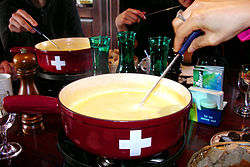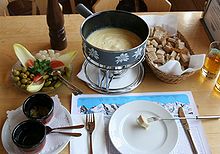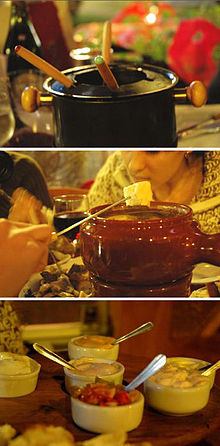- Fondue
-
Not to be confused with fondant.
Fondue is a Swiss and French dish of melted cheese served in a communal pot (caquelon) over a spirit lamp (rechaud), and eaten by dipping long-stemmed forks with bread into the cheese. It was promoted as a Swiss national dish by the Swiss Cheese Union in the 1930s and became popular in North America in the 1960s.
Since the 1950s, the name "fondue" has been generalized to other dishes where a food is dipped into a communal pot of hot liquid: chocolate fondue, where pieces of fruit are dipped into a melted chocolate mixture, and fondue bourguignonne, where pieces of meat are cooked in hot oil.
Contents
Etymology
The word fondue is the feminine passive past participle of the French verb fondre ('to melt') used as a noun, probably influenced by a Franco-Provençal word.[1] It is first attested in French in 1735, in Vincent la Chapelle's Cuisinier moderne,[2] and in English in 1878.[3]
History
The earliest known recipe for cheese fondue as we know it today comes from a 1699 book published in Zurich, under the name "Käss mit Wein zu kochen" 'to cook cheese with wine'.[4] It calls for grated or cut-up cheese to be melted with wine, and for bread to be dipped in it.
However, the name 'cheese fondue', until the late 19th century, referred to a preparation including eggs and cheese, as in la Chapelle's 1735 Fonduë de Fromage, aux Truffes Fraiches[2] and Brillat-Savarin's 1834 recipe;[5] it was something between scrambled eggs with cheese and a cheese soufflé.[6] Variations included cream ('à la genevoise') and truffles ('à la piémontaise') in addition to eggs; and also what we now call 'raclette' ('fondue valaisanne').[7]
The first known recipe for the modern cheese fondue under that name, with cheese and wine but no eggs, was published in 1875, and was already presented as a Swiss national dish.[8] Despite its modern associations with rustic mountain life, it was a town-dweller's dish from the lowlands of western, French-speaking, Switzerland: rich cheese like Gruyère was a valuable export item which peasants could not afford to eat.[9][10]
The introduction of cornstarch ("Maïzena") to Switzerland in 1905 made it easier to make a smooth and stable emulsion of the wine and cheese, and probably contributed to the success of fondue.[11]
Fondue was popularized as a Swiss national dish by the Swiss Cheese Union (Schweizerische Käseunion) in the 1930s as a way of increasing cheese consumption. The Swiss Cheese Union also created pseudo-regional recipes as part of the "spiritual defense of Switzerland".[12] After World War II rationing ended, the Swiss Cheese Union continued its marketing campaign, sending fondue sets to military regiments and event organizers across Switzerland. Fondue is now a symbol of Swiss unity.[12]
The dish became popular in the United States through the late 1960s and early 1970s. In the meantime, fondue continued to be promoted aggressively in Switzerland, with slogans like "La fondue crée la bonne humeur" 'fondue creates a good mood' and (1981) "Fondue isch guet und git e gueti Luune" 'fondue is good and creates a good mood'--abbreviated as "figugegl".[13]
The extension of the name 'fondue' to other dishes served in a communal hot pot dates to 1950s New York. Konrad Egli, a Swiss restaurateur who had popularized cheese fondue, introduced fondue bourguignonne at his Chalet Suisse restaurant in 1956. Then in the mid 1960s, he invented chocolate fondue as part of a promotion for Toblerone chocolate.[14] A sort of chocolate mousse was also sometimes called 'chocolate fondue'.[15]
Preparation
Cheese fondue consists of a blend of cheeses, wine and seasoning. To prepare the caquelon it is first rubbed with a cut garlic clove. White wine, cheese, and often kirsch are added and stirred until melted. A small amount of cornstarch or other starch is added to prevent separation. The mixture is stirred continuously as it heats in the caquelon.
When it is ready, diners dip cubes of bread speared on a fondue fork into the mixture.
Temperature and la religieuse
A cheese fondue mixture should be held at a temperature warm enough to keep the fondue smooth and liquid but not so hot as to allow any burning. If this temperature is held until the fondue is finished there will be a thin crust of toasted (not burnt) cheese at the bottom of the caquelon. This is called la religieuse (French for the nun). It has the texture of a thin cracker and is almost always lifted out and eaten.
Cheese fondues
Swiss
- Neuchâteloise: Gruyère and Emmental.
- Moitié-moitié (or half 'n half): Gruyère and Fribourg vacherin.
- Vaudoise: Gruyère.
- Fribourgeoise: Fribourg vacherin wherein potatoes are often dipped instead of bread.
- Innerschweiz: Gruyère, Emmental and sbrinz.
- Appenzeller: Appenzeller cheese with cream added.
- Tomato: Gruyère, Emmental, crushed tomatoes and wine.
- Spicy: Gruyère, red and green peppers, with chili.
- Mushroom: Gruyère, Fribourg vacherin and mushrooms.
French alpine
Italian alpine
- Fonduta: Fontina, milk, eggs and truffles, known as Fonduta valdostana in the Aosta valley and Fonduta piemontese in Piedmont, both in northern Italy.
Instant
Refrigerated fondue blends are sold in most Swiss supermarkets and need little more than melting in the caquelon. Individual portions heatable in a microwave oven are also sold.
Other fondues
Meat
- Fondue Bourguignonne consists of a fondue pot filled with hot oil into which diners dip pieces of meat to cook them. Various sauces are provided on the side. The dish is first attested in the mid-1950s.[16]
- Bressane: Small cubes of chicken breast are dipped in cream, then in fine bread crumbs and at last deep fried, as with a bourguignonne.
Chocolate
Slices of fruit or pastry are dipped in a caquelon of melted chocolate. Other types of dessert fondues can include coconut, honey, caramel and marshmallow.
Traditions and etiquette
A tradition says that if a man loses his bread in the pot, he buys drinks all around, and if a woman does, she must kiss her neighbors.[14]
Most writers recommend that each morsel be put in the pot only once (no double-dipping) and that the dipping fork be used only to transport the food from the pot to one's plate, not to eat.[17]
See also
- Fondue chinoise is a common French name for Chinese hot pot, where meat and vegetables are cooked in a shared pot of broth.
- Bagna càuda, a similar olive oil-based Northern Italian dish.
- Chocolate fountain
- Hot pot
- Raclette
- Welsh rarebit, a similar Welsh dish.
- List of cheese soups
References and notes
- ^ Trésor de la langue française, s.v. fondre, etymology section B.3.a.
- ^ a b Vincent la Chapelle, Le cuisinier moderne p. 220
- ^ Oxford English Dictionary, Second edition, 1989; online version November 2010. s.v.
- ^ Kochbuch der Anna Margaretha Gessner, 1699, cited by Albert Hauser, Vom Essen und Trinken im alten Zürich, cited by Isabelle Raboud-Schüle "Comment la fondue vint aux Suisses", Annales fribourgeoises 2007?
- ^ Jean Anthelme Brillat-Savarin, Physiologie du goût, 1834, p.338-9
- ^ Prosper Montagne, Larousse Gastronomique, 1938, p. 483, quoted in the Food Timeline FAQ
- ^ Joseph Favre, Dictionnaire universel de Cuisine, Paris 1894, cited by Raboud-Schüle, 2007
- ^ Louis Favre, L'habitation--le vêtement--les aliments. Manuel d'économie domestique à l'usage des écoles secondaires et primaires supérieures, Neuchâtel 1875, cited by Raboud-Schüle, 2007
- ^ Fabian Muhieddine, "La fondue: un coup marketing de 1930!", Le Matin.ch, reporting on a lecture by Isabelle Raboud-Schüle full text
- ^ Raboud-Schüle, p. 4-5
- ^ Raboud-Schüle, p. 5
- ^ a b Isabelle Raboud-Schüle, director of the Musée gruérien, interview "History of Cheese Fondue" [1]
- ^ Raboud-Schüle, p. 7
- ^ a b Sylvia Lovegren, Fashionable Food: Seven Decades of Food Fads, pp. 240-2
- ^ Barry Popik, The Big Apple blog, "Chocolate Fondue (myth)"
- ^ The earliest mention found by Google Books in December 2010 is Pat Smythe, One jump ahead, 1956 snippet
- ^ Ellen Brown, The Complete Idiot's Guide to Fondues and Hot Dips, p. 10
Further reading
- Isabelle Raboud-Schüle, "Comment la fondue vint aux Suisses", Annales fribourgeoises 2007?
External links
- Fondue at the Open Directory Project
Cheese dishes Aligot • Almogrote • Arizona cheese crisp • Bacon, egg and cheese sandwich • Beer cheese (spread) • Bryndzové halušky • Cauliflower cheese • Cervelle de canut • Cheese bun • Cheesecake • Cheese dream • Cheese fries • Cheese on toast • Cheese pudding • Cheese puffs • Cheese roll • Cheese sandwich • Chèvre chaud • Chhena Gaja • Chhena Kheeri • Chhena jalebi • Chhenna Poda • Croque-monsieur • Fondue • Frico • Gougère • Guvchelvka • Hauskyjza • Insalata Caprese • Kasseropita • Lasagna • Liptauer • List of cheese soups • Macaroni and cheese • Mattar paneer • Moretum • Mornay sauce • Mozzarella sticks • Nachos • Obatzda • Pastizz • Pimento cheese • Poulet au fromage • Poutine • Provoleta • Quesadilla • Quesito • Raclette • Rasabali • Saganaki • Schmear • Shahi paneer • Smažený sýr • Sopapilla cheesecake • Spanakopita • Supplì • Syrniki • Tirokafteri • Tiropita • Túrós csusza • Urnebes • Vatrushka • Welsh rarebitCategories:- Swiss cuisine
- Cheese dishes
- Table-cooked dishes
- Cooking techniques
Wikimedia Foundation. 2010.



